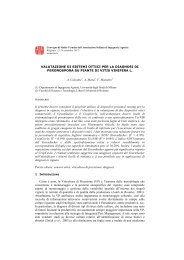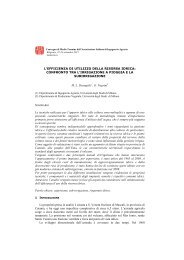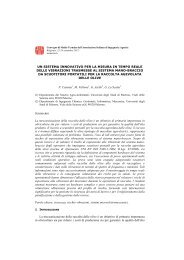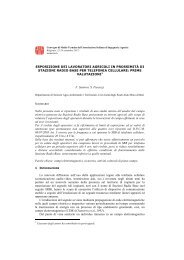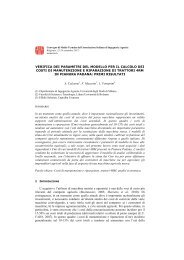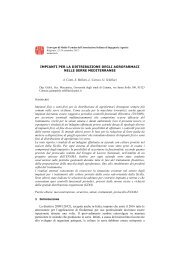numerical simulation of armour layer development under ... - AIIA2011
numerical simulation of armour layer development under ... - AIIA2011
numerical simulation of armour layer development under ... - AIIA2011
You also want an ePaper? Increase the reach of your titles
YUMPU automatically turns print PDFs into web optimized ePapers that Google loves.
Convegno di Medio Termine dell’Associazione Italiana di Ingegneria AgrariaBelgirate, 22-24 settembre 2011memoria n.NUMERICAL SIMULATION OF ARMOUR LAYER DEVELOPMENTUNDER CONDITIONS OF SEDIMENT STARVATIONG. Kaless 1(*) , L. Mao 2(1) Department <strong>of</strong> Land and Agro-forest Environment, University <strong>of</strong> Padova, (*) Cor. Author(2) Faculty <strong>of</strong> Science and Technologies, Free University <strong>of</strong> Bozen-BolzanoABSTRACTGravel‐bed rivers in perennial regimes are usually characterized by a coarser surface<strong>layer</strong> <strong>of</strong> sediment, commonly called <strong>armour</strong> <strong>layer</strong>, which influence bedload transport, aswell as hyporheic flows and fish habitats. If the <strong>armour</strong> is created by selective transport<strong>of</strong> finer sediment fraction from the bed, it is called static, and can be replicated inlaboratory if no sediment is fed from upstream. The paper presents a relatively simple<strong>numerical</strong> modelling approach to simulate <strong>armour</strong>ing processes, which has beenapplied to replicate bedload transport measured during static <strong>armour</strong>ing flumeexperiments in order to assess the performance <strong>of</strong> few bedload formulas. Overall, themodel proved to be able to simulate well the vanishing sediment transport due toboth slope reduction and surface coarsening. All formulas tend to overpredict theactual sediment transport, especially at the lower rates, and to <strong>under</strong>estimate thegrain size <strong>of</strong> transported material.Keywords: <strong>armour</strong> <strong>layer</strong>, <strong>numerical</strong> modelling, bedload formulas.1 INTRODUCTIONGravel‐bed rivers typically exhibit an <strong>armour</strong>ed surfaces covering a finer subsurfacemix <strong>of</strong> sediments. The coarser surface has implications for hyporheic flow exchange,fish habitats, and bedload transport estimation (e.g. Bathurst, 2007). The amour is calledstatic when is created by a flow that selectively entrains only the finer elements (Churchet al., 1998) from a non-uniform bed material. Static <strong>armour</strong> is typical in sedimentsupply-limitedsystems (e.g. reaches located downstream <strong>of</strong> lakes or dams). Armouringprocess has been observed both experimentally and in the field and its extent dependson the flow strength applied to the bed and the grain size distribution <strong>of</strong> the bed mixture(Church et al., 1998).In a flume, static <strong>armour</strong> is usually created exposing a non-uniform mixture to aconstant flow rate with no sediment input. After a first phase <strong>of</strong> bed degradation whichcauses an initial decrease in the slope <strong>of</strong> the bed, there is a gradual increase <strong>of</strong> thesurface grain size distribution. Under these conditions, sediment transport rate is at itsmaximum during the first short period, and then gradually decreases (Pr<strong>of</strong>fitt, 1980;Tait et al., 1992; Aberle & Nikora, 2006; Mao et al., 2011). Pr<strong>of</strong>fitt (1980) showed thatthe <strong>development</strong> <strong>of</strong> a static <strong>armour</strong> involves both the elective transport <strong>of</strong> the finer
G. Kaless, L. Maoparticles and a following re-arrangement <strong>of</strong> the coarser fractions. Using a laser scannerdevice, Mao et al. (2011) recently depicted the highly structured and imbricated nature<strong>of</strong> the static <strong>armour</strong> <strong>layer</strong>s, which became topographically less complex at higherforming flow strengths, with significant implications for sediment mobility and bedroughness. Static <strong>armour</strong> <strong>development</strong> as observed in flume experiments has beensimulated <strong>numerical</strong>ly with success using different approaches (e.g. Ashida & Michiue,1971; Pr<strong>of</strong>fitt, 1980; Bettess & Frangipane, 2003). The aim <strong>of</strong> the present work is topresent a simple approach for reproducing <strong>numerical</strong>ly static <strong>armour</strong> <strong>development</strong>, todiscuss the <strong>simulation</strong> <strong>of</strong> the sediment transport rate reduction through time, and toassess the best performing bedload formula.2 MATERIALS AND METHODS2.1 Numerical modellingThe <strong>numerical</strong> model is intended to predict the evolution <strong>of</strong> the bed pr<strong>of</strong>ile and thesurface grain size distribution given a certain flow strength and a sediment transportcapacity. The model is based on mass and energy conservation principles and fractionssediment transport process is described by means <strong>of</strong> the sediment conservation equationand a sediment transport model. Being developed for poorly‐sorted sediment grain‐sizemixtures, the model is based on the Parker & Sutherland (1990) extension to theExner’s conservation equation for the case <strong>of</strong> heterogeneous mixtures. Parker &Sutherland (1990) model considers a surface <strong>layer</strong> that directly interacts with sedimenttransport and a subsurface <strong>layer</strong> that interacts with the upper <strong>layer</strong> by means <strong>of</strong>degradation/aggradation:∂z∂t = − 1 ∂q bT1 − λ p ∂x(1)∂F si∂t = 1 ∂(z − L a )*fL Iia ∂t− F si∂L a∂t − ∂q bi∂x 4where q bT is the total volumetric sediment transport, λ P is the sediment porosity, F si ,and f Ii are the volume fraction <strong>of</strong> material in the i th grain size range corresponding to thesurface <strong>layer</strong>, and the exchanged material between <strong>layer</strong>s, respectively; L a is thethickness <strong>of</strong> the active <strong>layer</strong> and q bi is the volumetric sediment transport <strong>of</strong> the i th grainsize range. In case <strong>of</strong> bed degradation, the surface grain size distribution equals thesubsurface mixture, whereas in the case <strong>of</strong> bed aggradation a linear mixing modelconsidering bedload grain size and the <strong>armour</strong> <strong>layer</strong> is applied (Hoey & Ferguson,1994). As to the active <strong>layer</strong>, its thickness is comparable to the surface D 90 (size such90% <strong>of</strong> material is finer).The sediment transport process can be described by many models based on thesurface material. For this study two models based on field data (Parker, 1990 andPowell et al., 2003) and three models derived from flume experiments (Wilcock &Crowe, 2003; Wu et al., 2000 and Hunziker & Jaeggi, 2002) have been selected. All themodels are suitable for computing fractional sediment transport (i.e. the transport <strong>of</strong>each grain size classes is calculated separately).The model has been applied to simulate static <strong>armour</strong> <strong>development</strong> in a closed(2)
G. Kaless, L. MaoTable 2 exposes bed load mean diameter averaged along the <strong>simulation</strong> span. As acommon rule, predictions for all the cases are below the actual measurements. Wilcock& Crowe’s model and Hunziker & Jaeggi’s models have the lowest differences, whileWu et al.’s predictions are half the observed magnitudes.4 DISCUSSIONDuring the first phase <strong>of</strong> the experiments that bed degrades, are flume conditionssimilar to those founded in ephemeral streams? In absence <strong>of</strong> an <strong>armour</strong> <strong>layer</strong> flowconditions are intense (dimensionless shear stress between 0.06 and 0.09) as well assediment transport (upto 207 gr m -1 s -1 ). Powell et al. (2003) studied the sedimenttransport <strong>of</strong> two streams located in a semiarid context. Sediment transport was very high(in the range <strong>of</strong> 10 1 to 10 5 gr m -1 s -1 ) as well as dimensionless shear stress (above 0.04upto 0.4); furthermore, both streams lacked for an <strong>armour</strong> <strong>layer</strong>. Laboratory initialconditions are within the range <strong>of</strong> validity <strong>of</strong> the empirical relation. Therefore the modelhas been able to predict very well the sediment transportAlthough flow strength can be high in the experiments it is even within the range <strong>of</strong>validity <strong>of</strong> relations derived from laboratory experiments (such as Wilcock and Crowe,2003; Hunziker & Jaeggi, 2002; and Wu et al., 2000) or direct measure in streams but inhumid climates (like Oak Creek analyzed by Parker, 1990). After the first phase, thereis increase in surface grain size. Simulating the <strong>development</strong> <strong>of</strong> a static <strong>armour</strong> <strong>layer</strong>with mobile-<strong>armour</strong>-based relations can induce a systematic error. Laboratoryexperiments show that static <strong>armour</strong> <strong>layer</strong>s are coarser than mobile <strong>layer</strong>s <strong>under</strong> thesame flow strength (Mao et al, 2011). Furthermore, interlocked grains or clustersincrease the dimensionless critic shear stress, so that grains have more resistance tomove in the presence <strong>of</strong> static <strong>armour</strong>s. These experimental findings are furthersupported with field evidence (Church et al, 1998). It follows that, if we interpret the<strong>simulation</strong>s in a mobile <strong>armour</strong> context, then it is expected that sediment transportprediction should be higher than observed, and grain size distribution for predicted bedload should be finer than actually measured. This reasoning may explain the systematicdiscrepancies between observations and predictions from Wilcock and Crowe’s,Parker’s and Wu et al.’s models.The findings aforementioned seem to be in contradiction with Hunkizer & Jaeggi’smodels results. The <strong>simulation</strong>s show a good agreement for solid discharges above 3 grm -1 s -1 , and <strong>under</strong>predictions for discharges below this value. These authors proposed atransport relation with a dimensionless threshold for shear stress. That is, if shear stressis below this threshold then there is no sediment transport. A close inspection <strong>of</strong><strong>simulation</strong> results reveals that during the first stage (above the 3 gr m -1 s -1 ) thetransported material is mainly coarse and similar to the filling material. Progressively, ittends to get finer, indicating the formation <strong>of</strong> the <strong>armour</strong> <strong>layer</strong> by selective transport <strong>of</strong>fine sizes and erosion. As the surface coarsers and slope decreases, the shear stressdecreases approaching the threshold value, and due to the structure <strong>of</strong> the transportrelation, sediment transport falls quickly.5 CONCLUSIONSA one-dimensional hydraulic model able to solve the steady state gradually varied



